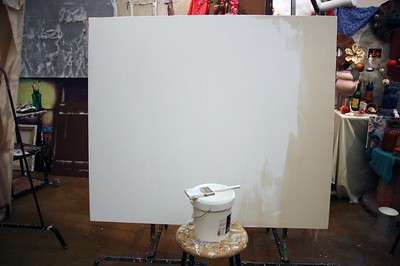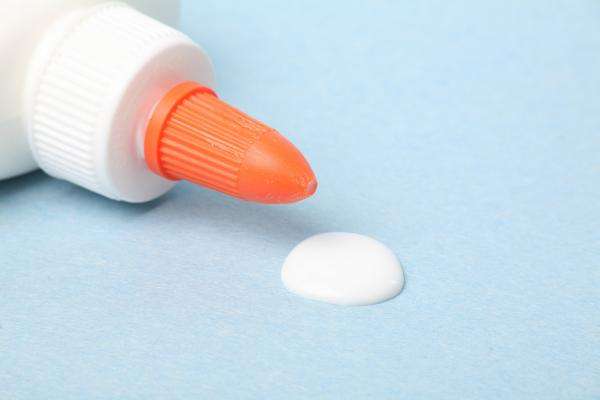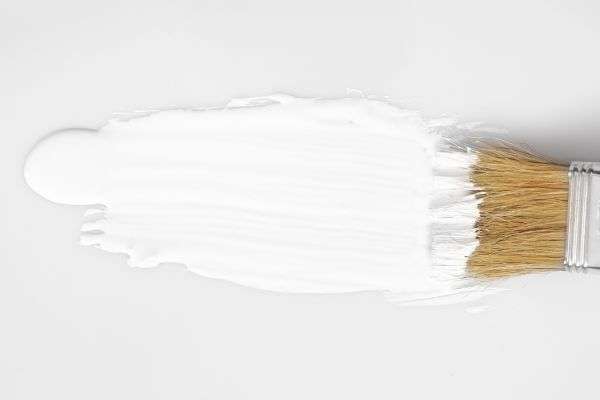Preparing a canvas is integral to painting because a good base provides a smooth and balanced texture. Applying Gesso to the canvas is a critical part of surface preparation because Gesso is a primer that can cause cracks if not applied properly.
Table of Contents
- What is Gesso?
- What is Acrylic Gesso?
- How to apply Gesso to the canvas?
- How to apply Gesso to canvas for oil painting
- How to prime a canvas for oil painting without Gesso
- What can I use instead of Gesso for oil painting
- Can Gesso be used as paint?
- Can I use white acrylic instead of Gesso?
- How to make Gesso?
- Cool things to do with Gesso
- Is Gesso necessary for acrylic painting
- Can I use Gesso to cover an old acrylic painting
- Final Words
This blog aims to provide a complete step-by-step process on how to apply Gesso to the canvas in different mediums. Whether you are going to do oil painting or acrylics, this technique will help you to prepare a canvas for any medium.
What is Gesso?
The word Gesso is derived from the Italian word dʒɛsso, derived for calcium carbonate and chalk. Gesso is a chalk or an art accessory made by mixing calcium carbonate with lead white pigment and a binder. It was first invented in 1955 by Henry Levison. At that time, Henry Levison named it Liquitex. It has perfect properties to become a primer because it is thinner than paint but is more complicated than that paint.
In the 19th Century, Gesso was made with a natural binder such as animal glue that took from rabbit skin, chalk, and white pigment. Today, modern Gesso is available in many forms, such as white Gesso, which is known as regular Gesso, black Gesso, white Gesso, and transparent Gesso. Surface priming is essential to create a beautiful painting. That’s why Gesso is popular amongst artists.
What is Acrylic Gesso?
Acrylic Gesso is a primer used to prepare the surfaces for acrylic paintings. An acrylic gesso is made by mixing an acrylic medium with chalk or calcium carbonate and glue. It is a good choice for artists who want to make their work more durable and flexible.

The acrylic Gesso was first invented in the mid-19th century when these paints were also discovered. Its invention creates improvements by providing more flexibility, durability, and adhesion for the paints to stick to the surfaces.
How to apply Gesso to the canvas?
Applying process is essential; no matter if you are using homemade Gesso, you must know the application process, which is not hard.
How much quantity of Gesso should need to be applied for every canvas? Try to create a thin layer of Gesso around 1mm thick. You can prime as many layers at one time, but these layers must cover all the pores of the canvas.
Things To Need:
- Canvas
- Gesso
- Paintbrush
- Water & sandpaper (Optional)
Steps to Follow:
- Clean your canvas and remove dust and dirt using a clean cloth piece. Priming is beneficial even if you have already pre-primed canvas.
- Take a clean paintbrush and wipe it over the canvas.
- Now, apply Gesso using a paintbrush. Use a broad brush for a large canvas and a small brush for a small one. Apply Gesso like regular paint and cover the whole surface with it.
- Allow some time to dry for the first layer. Gesso is a fast dryer, and it will not take much time to dry. (30 minutes)
- After applying the first layer, another layer can be applied to get desired results.
- If you notice any bumps over the canvas after priming, you can do sanding to remove them.
How to apply Gesso to canvas for oil painting
Gesso is an art supply that prepares the canvas to accept the painting process. For oil painting, there is no specific difference in applying Gesso to the canvas to other mediums; so you can follow the above procedure. But which type of Gesso you will use is totally up to you. I recommend using Winsor & Newton’s white acrylic gesso.

Prepare the canvas by removing any dust from the surface. Apply a thin layer of Gesso with a paintbrush. Use a broad brush for large surfaces and trim for small surfaces. For ease, follow the above step-by-step procedure.
How to prime a canvas for oil painting without Gesso
There are two alternatives to prime a canvas for oil painting without Gesso:
- Prime a canvas with titanium white oil paint
- Prime a canvas with acrylic paint
1. Priming a canvas with titanium white oil paint
Priming with titanium white is good for getting the same results as the original Gesso. It would help if you had the following things:
- Canvas
- Glue
- Paintbrush
- Titanium white oil paint or talcum powder
Procedure:
First, prepare a Gesso-like mixture by pouring ¼ cup of hot water into a bowl. Add ¼ cup of PVA glue and mix the solution very well. Now add ½ cup of titanium white oil paint or talcum powder to the solution and mix all the solution very well.
Clean the canvas with a cloth piece or a paintbrush. Apply a thin layer of the mixture over the surface of the canvas. The layer should be fragile (no more than 1mm). Let the layer dry for half an hour, and now you can apply additional layers according to the desired results.
2. Priming a canvas with acrylic paint
Using acrylic paint as a primer will be easier because you don’t have to make any mixture. You can apply it directly to the canvas using a paintbrush of any size. If you are wondering about using oil paint over an acrylic primer, then I want to let you know that there is no trouble if you do oil over acrylics because it will not affect the painting process. However, you cannot do acrylics over oils. You are going to get the same results as the original Gesso.
What can I use instead of Gesso for oil painting
Instead of Gesso, you can use animal or PVA glue mixed with water, acrylic paint, or spray primer to prime your canvas for oil painting. Instead of using Gesso, you can use some of these methods but don’t try to skip the priming because you will not get any good results without it. Using any of these methods will give 70% identical results as Gesso.
PVA glue, also known as white glue, is children’s friendly. If you don’t have any talcum powder or calcium carbonate, mix PVA glue with ½ cup of water and ½ cup of PVA glue to make a gesso-like mixture. However, you cannot get white colour with this mixture like the original Gesso, but the results will be good.

Using acrylic paint as a primer is also a wise option because acrylic primers are also best for oil painting surface priming. You can use any acrylic paint colour for priming purposes; white is recommended. Just apply one coat of acrylic paint and let it dry for some minutes.
Using a spray primer is also a good option, but it will be more costly. For the procedure, you need a spray primer or gesso spray. Put the canvas on a table, spray the primer over it horizontally, and let it dry for a few hours.
Can Gesso be used as paint?

Gesso is a primer mainly used to prepare the canvas for painting but can be used as a paint for some specific purposes. You must need to aware of the following facts about using Gesso as a paint:
- Gesso is thicker in consistency than acrylic paints, but oil paints are thicker than Gesso. In the case of acrylics, you can add some water to adjust the consistency of the Gesso, but for oils, you cannot use acrylic Gesso as paint in any way.
- The texture of Gesso may not be suitable for all painting styles, but you can use Gesso for acrylics. I don’t recommend using Gesso as a paint for oil paintings.
- You can cover the mistakes with Gesso because it has opaque coverage. But if you are looking for some transparent coverage, Gesso is not a suitable option.
- Gesso dries quickly, so you have to work quickly with Gesso as a paint. But once it dried, you can paint other paints over it.
Can I use white acrylic instead of Gesso?
White acrylic paint can be used instead of Gesso because the ingredients of white acrylic paint are the same as a gesso: pigment, binder, and water. The ingredients of Gesso are calcium carbonate, binder, and water so you can use white acrylic paint instead of Gesso.
Acrylic paint is a suitable option to prime a canvas for oils and acrylics because you can work with oil paints over acrylic paint without any problem.
How to make Gesso?
The primary ingredient to make Gesso is calcium carbonate, which can be substituted with Plaster of Paris, Talcum powder, chalk powder, gypsum, or titanium white. That means you can make Gesso with any of the following ingredients.
To make Gesso, you must mix some ingredients like one part of water, one part of binder, and two parts of calcium carbonate.
Things to Need:
- Any binder or glue
- Plaster of Paris/ Calcium Carbonate/ Chalk powder/ Gypsum/ Talcum powder/ Corn starch
- Water
- Bowl or jar
Steps:
- Take a small bowl or jar and pour ¼ cup of water. It is best if you boil the water first.
- Add ¼ binder to the cup and mix the ingredients thoroughly.
- Add ½ of the plaster of Paris and remix the mixture.
- Adjust the consistency of the mixture with water.
Cool things to do with Gesso

Gesso is a primer, but its uses are broad. You can do many cool and fun things with Gesso, such as creating textured surfaces, creating mixed media art, making art journals, making three-dimensional art, using it as glue, creating a texture with stencils, creating a chalkboard surface, and many more.
Creating textured surfaces
It is the most common use of Gesso, and we all use it to get a textured surface ready to accept the painting process. It can be done on various surfaces, including wood, canvas, or paper.
Creating a mixed media art
Gesso can be used as a base for many painting techniques and can accept oils, acrylics, inks, and many other mediums. Using Gesso as a base for various techniques is a great way to create mixed-media art. For example, you can create a watercolour painting over Gesso using ink, acrylics, and watercolours.
Art Journals
Yes, you can use your Gesso for art journals. Apply a thin layer of Gesso over the paper, and you are ready to write on it.
Three Dimensional Art
You can build some layers of Gesso over the surface that can be used to create any three-dimensional art because Gesso gets thick after drying. You can create three-dimensional effects after drying Gesso.
Using Gesso as a glue
Gesso can be used as a glue to adhere fabrics and paper pieces. However, this glue won’t adhere to any heavy plastic. Metal or concrete pieces.
Texture with stencils
Gesso can also be used to create images with stencil artwork. You can use it as a texture enhancer to create better artwork with stencils.
Chalkboard surface
You can also create a whiteboard with Gesso to write with chalk like a blackboard.
Is Gesso necessary for acrylic painting
Using Gesso is not necessary, but it is highly recommended because it has the following advantages:
- It can help to prevent the paint from soaking into the canvas
- It helps to create a smooth surface
- It also improves the quality of the paint
- It is also recommended for better adhesion of the paint with canvas
Gesso can help you prevent the paint from soaking into the surface and get a smooth surface; it helps improve the quality of paint and improve adhesion.
However, all these advantages are necessary to create a masterpiece. A masterpiece cannot be created without a primed surface. From my perspective, Gesso is more valuable than “Necessary” for acrylic painting.
Can I use Gesso to cover an old acrylic painting
Gesso can cover an old acrylic painting, and often, artists on youtube also recommend using it to cover old acrylic paintings because you can work over it again.
To cover an old acrylic painting, this is highly recommended to use white Gesso, and sanding is also beneficial to remove any bumps on the surface.
Final Words
Priming is fruitful for any technique of painting but every artist should acquire good knowledge about priming a canvas; especially with gesso. Gesso is a primer that is helpful to create smooth, balanced, and even surfaces for painting, ideal for oil painting. Today, modern canvas from the market comes in triple, double, and single coating of gesso but that is useless until we prime those surfaces with ourselves.
I hope your canvas must be ready after reading this 8-minute blog and I am really happy that the curiosity of knowledge still insisting your mind to read this blog.
More From Us About Gesso:

Hi,
I like the above information but I have some doubts.
‘can I use gesso on acrylic paper?’
Hi Hafsay,
Hope all going well! Yes, you can apply gesso on acrylic paper if you want. However, applying gesso on acrylic paper is not recommended.
Regards,
Uzair Younas